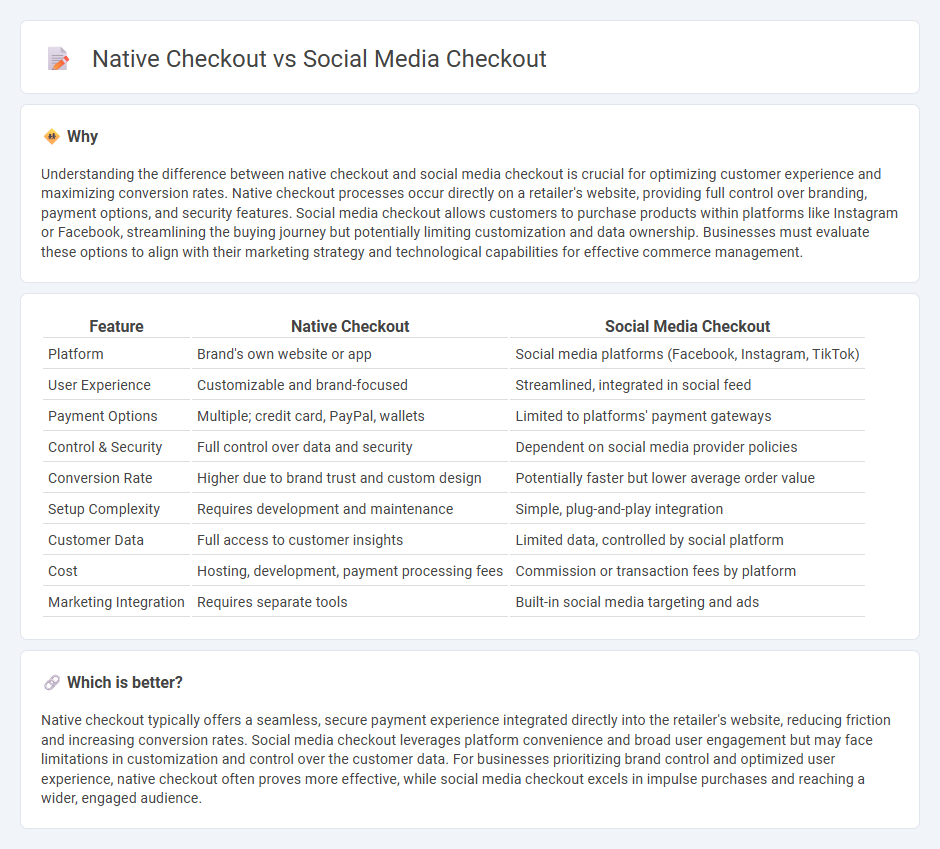
Native checkout streamlines the purchasing process by allowing customers to complete transactions directly on a brand's website, enhancing security and reducing cart abandonment. Social media checkout integrates with platforms like Instagram and Facebook, enabling users to buy products seamlessly within their social feeds, boosting impulse purchases and engagement. Explore the benefits and challenges of each checkout method to optimize your e-commerce strategy.
Why it is important
Understanding the difference between native checkout and social media checkout is crucial for optimizing customer experience and maximizing conversion rates. Native checkout processes occur directly on a retailer's website, providing full control over branding, payment options, and security features. Social media checkout allows customers to purchase products within platforms like Instagram or Facebook, streamlining the buying journey but potentially limiting customization and data ownership. Businesses must evaluate these options to align with their marketing strategy and technological capabilities for effective commerce management.
Comparison Table
| Feature | Native Checkout | Social Media Checkout |
|---|---|---|
| Platform | Brand's own website or app | Social media platforms (Facebook, Instagram, TikTok) |
| User Experience | Customizable and brand-focused | Streamlined, integrated in social feed |
| Payment Options | Multiple; credit card, PayPal, wallets | Limited to platforms' payment gateways |
| Control & Security | Full control over data and security | Dependent on social media provider policies |
| Conversion Rate | Higher due to brand trust and custom design | Potentially faster but lower average order value |
| Setup Complexity | Requires development and maintenance | Simple, plug-and-play integration |
| Customer Data | Full access to customer insights | Limited data, controlled by social platform |
| Cost | Hosting, development, payment processing fees | Commission or transaction fees by platform |
| Marketing Integration | Requires separate tools | Built-in social media targeting and ads |
Which is better?
Native checkout typically offers a seamless, secure payment experience integrated directly into the retailer's website, reducing friction and increasing conversion rates. Social media checkout leverages platform convenience and broad user engagement but may face limitations in customization and control over the customer data. For businesses prioritizing brand control and optimized user experience, native checkout often proves more effective, while social media checkout excels in impulse purchases and reaching a wider, engaged audience.
Connection
Native checkout streamlines the purchasing process by allowing customers to complete transactions directly on a retailer's website or app, enhancing user experience and reducing cart abandonment rates. Social media checkout integrates this functionality within social platforms like Instagram and Facebook, enabling seamless in-app purchases without redirecting users elsewhere. Both methods leverage secure payment gateways and user data to optimize conversion rates and provide a frictionless shopping journey.
Key Terms
Conversion Rate
Social media checkout streamlines the purchasing process by allowing customers to complete transactions directly within social platforms, significantly reducing cart abandonment and boosting conversion rates by up to 20%. Native checkout, integrated within an e-commerce website, offers more control over branding and customer experience, which can enhance trust and result in higher average order values. Explore detailed insights on how these checkout options impact conversion rates to optimize your sales strategy effectively.
User Experience
Social media checkout streamlines the purchasing process by allowing users to complete transactions within the platform, reducing friction and enhancing convenience. Native checkout offers a more secure and customizable experience, often providing better integration with payment gateways and customer support. Explore detailed comparisons to understand which checkout solution best improves your user experience.
Data Ownership
Social media checkout systems often limit direct access to customer data, restricting businesses' ability to fully own and utilize this information for marketing and personalization. Native checkout platforms offer greater data control, enabling comprehensive customer insights and stronger data privacy compliance. Explore further to understand how data ownership impacts your sales strategy and customer relationships.
Source and External Links
The Rise of Social Media Checkout: What You Need To Know - Social media checkout allows customers to buy products directly within apps like TikTok and Instagram through integrated ecommerce and payment processing, providing a seamless shopping experience without leaving the platform.
How to Leverage Social Media Shopping Features to Boost Sales - Platforms such as Facebook Shops let businesses create branded storefronts with customizable catalogs, integrated customer support, and in-app checkout options that streamline purchases and enhance visibility and analytics.
What is social commerce? | Latest trends for 2023 - Instagram Checkout, Facebook Shop, TikTok Commerce, and Pinterest Shopping are leading social commerce solutions enabling users to buy products quickly within these social media platforms, featuring stored payment info and notifications on shipping and delivery.
 dowidth.com
dowidth.com